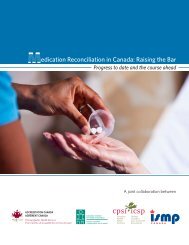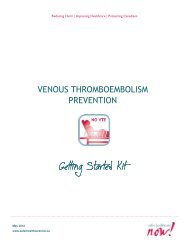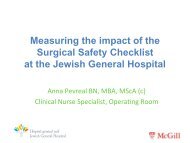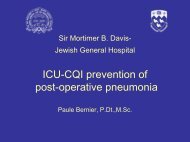VAP Getting Started Kit - Safer Healthcare Now!
VAP Getting Started Kit - Safer Healthcare Now!
VAP Getting Started Kit - Safer Healthcare Now!
You also want an ePaper? Increase the reach of your titles
YUMPU automatically turns print PDFs into web optimized ePapers that Google loves.
<strong>Safer</strong> <strong>Healthcare</strong> <strong>Now</strong>! Prevent Ventilator Associated Pneumonia <strong>Getting</strong> <strong>Started</strong> <strong>Kit</strong><br />
tract including the mouth and oropharynx become colonized with pathogenic organisms soon<br />
after ICU admission. 79 As previously discussed, measures to prevent <strong>VAP</strong> that aim to reduce the<br />
quantity of aspirated pathogenic bacteria, such as the reduction of bacterial loads in the<br />
oropharynx with antiseptic mouth care and elevation of the head of the bed, have also been<br />
shown to be effective in reducing <strong>VAP</strong>. 36,80<br />
There has been increasing research on endotracheal tube (ETT) design as a means of reducing<br />
the risk of <strong>VAP</strong>; these include changes to materials composing the tube, changes to cuff design<br />
and subglottic secretion drainage (SSD). Kollef et al. studied the effects of silver coated ETTs<br />
versus conventional ETTs and found that there was a 35.9% decrease in <strong>VAP</strong> in patients intubated<br />
longer than 24 hours receiving silver coated ETTs with a number needed to treat of 37 to prevent<br />
1 case of <strong>VAP</strong>. 81 Several mechanisms were postulated; silver has broad-spectrum antimicrobial<br />
activity, prevents bacterial adhesion to the ETT and may prevent biofilm formation. However,<br />
there were no differences in duration of MV, length of ICU stay and overall mortality. This study<br />
has several limitations including a low incidence of <strong>VAP</strong>, increased presence of patients with<br />
chronic obstructive lung disease and a high rate of pneumonia within 24 hours in the control<br />
group. Even though they are costlier than conventional ETTs, in an economic analysis of silver<br />
coated ETTs they were found to be associated with cost savings. 82 Nevertheless, silver coated<br />
ETTs have only been studied in a single RCT with significant limitations and further studies are<br />
required to determine the role of these novel ETTs, specifically in relation to other <strong>VAP</strong><br />
preventive strategies.<br />
The prevention of aspiration of pathogen laden secretions that accumulate above the<br />
inflated cuffs of ETTs has also been the research since there is increasing evidence that<br />
standard cuffs do not prevent micro-aspiration due to folds in the membrane when<br />
inflated and pressed against tracheal mucosa. 1 To reduce micro-aspiration around the<br />
cuff research has focused on cuff design improvements, the reduction of secretions<br />
accumulating above the cuff through sub-glottic secretion drainage (SSD) or both.<br />
Cuff design changes have focused on the geometry of the cuff or the cuff material. Changing the<br />
cylindrical shape of the cuff to a tapered one such that there is a better zone of apposition to<br />
the tracheal mucosa has been found to reduce aspiration in lab models by 90%. 83,84 However,<br />
clinical studies studying the significance of this have not been published and these are required.<br />
The replacement of standard polyvinyl chloride cuffs with an ultra thin polyurethane cuff (PUC)<br />
also decreases fluid leakage around the cuff. There are two clinical studies studying the effect<br />
of these type of cuffs. In one randomized clinical study of a PUC cuffed ETT combined with SSD,<br />
there was a significant reduction in the rate of <strong>VAP</strong>. 85 However, a standard ETT was utilized in<br />
the control group in this study and it is unclear if the reduction in <strong>VAP</strong> rate was the result of the<br />
PUC cuff or the SSD. The second study of a PUC cuffed ETT employed a time series analysis. 86<br />
With the replacement of standard ETTs with a PUC cuffed tube the rate of <strong>VAP</strong> fell and then rose<br />
slightly when the tubes were withdrawn. Given the large amount of clinical evidence for SSD,<br />
the role of PUC cuffed tubes remains to be determined.<br />
June 2012 20














